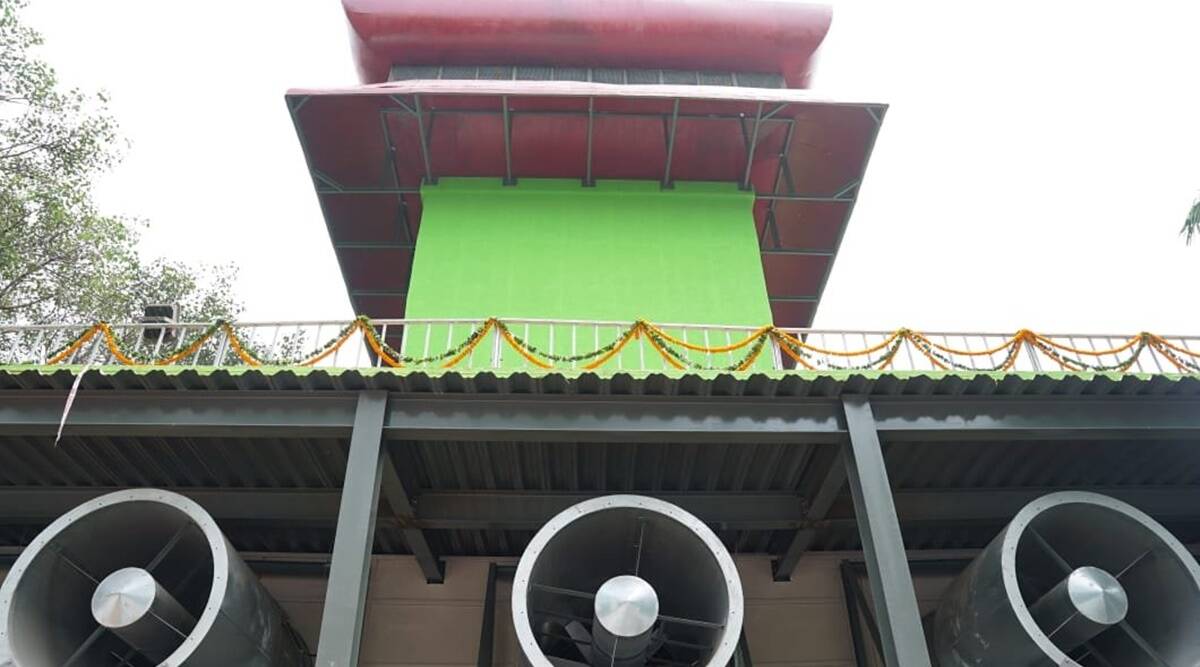 The tower is a 24-metre-high structure near the Shivaji Stadium metro station. It takes in air at the top that is then passed through filters and released at the bottom of the tower. (Image source: AAP/Twitter)
The tower is a 24-metre-high structure near the Shivaji Stadium metro station. It takes in air at the top that is then passed through filters and released at the bottom of the tower. (Image source: AAP/Twitter)After some hiccups over the past one year resulting from no clear protocol on its operation, the smog tower at Delhi’s Connaught Place is set to begin functioning round the clock once again this winter in what could be a crucial season to determine its performance.
A source in the Delhi government said that the tower had “underperformed” last winter. While it did function round-the-clock last winter, it has been operating for around eight to twelve hours only recently.
“Last year, when the smog tower began functioning, it was the first such tower to be running on this sort of technology in the world. There was no outdoor cleaning system working on this technology and with these filters, and that meant that there was no study available and no experience in operating a system like this. There was no standard operating procedure,” the source said.
The tower is a 24-metre-high structure near the Shivaji Stadium metro station. It takes in air at the top that is then passed through filters and released at the bottom of the tower. Around 40 fans operate at the bottom of the tower, which was set up after a Supreme Court order and inaugurated on August 23 last year.
In the year since then, problems emerged. The sensors – a total of eight, four at the inlets and four at the outlets – that are placed to collect data, were not placed correctly and not giving proper readings. There were issues with the filters as well, which would get dislodged at high fan speeds. “Leaks” that allowed polluted air into the system were detected in a few places.
“It also rained in October last year. If it is operated when it rains, moisture will enter the system and the filters will be destroyed and its efficiency will reduce. By the time Diwali season came last year, the filters were damp and were getting dislodged,” the source said.
A team from IIT Bombay, which is conducting a two-year long study on the tower’s performance recently submitted an interim report on it based on observations made over the past one year. The report will be examined and discussed by a committee of experts before it is finalised.
“Preliminary data suggests that when the fans are functioning at 50 to 75 per cent of their speed, there was a 15 to 20 per cent reduction efficiency at 300m from the tower,” the source said.
This is the rough reduction efficiency of PM10 and PM2.5, though the reduction efficiency for PM10 is higher than that for PM2.5, the source said, adding, “The farthest we know now is 300 m. Measurement at 100 per cent fan speed has not been provided yet.” The expected area of influence of the tower was 1 km, according to information provided by the Delhi Pollution Control Committee (DPCC) last year.
Data is being monitored at around 15 to 16 locations outside the tower, and ten of these are stationary devices. Wind speed, wind direction and the height of other structures in the vicinity are also important in deciding the tower’s performance and its zone of influence. “For people living in the immediate vicinity of around 300 m to 400 m, it can be an air cleaning device,” the source added.
Now, the filters will be replaced by October 3, the leaks have mostly been plugged, and the tower is likely to begin operating round-the-clock from around mid-October onwards. It used to run from around 8 am to 8 pm, but will now run through the night and data will be collected during the night as well to determine the effect of the tower when calm conditions set in and wind speed is low.
Efforts are also underway to optimise the tower’s functioning – ensure that it shuts down automatically when pollution levels are low or when moisture levels are high – and bring down energy consumption by exploring hybrid models including solar to reduce the operation and maintenance costs.
The DPCC is the nodal agency for the tower at Connaught Place. It is being operated by Tata Projects, while National Buildings Construction Corporation Limited (NBCC) is the project management consultant.